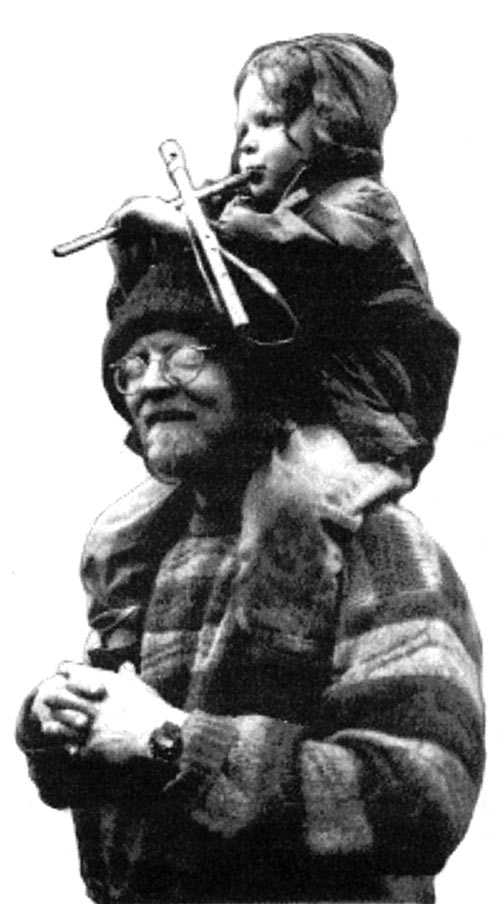
Ancient Royal Charter Vs Criminal Justice Act
Tan Hill Fayre was the first of many attempts to re-establish our ancient right to celebrate traditional country fayres. Heather James recalls the first stand-off.
Squall 11, Autumn 1995, pg. 23.
The Tan Hill Fayre was set up by Royal Charter by Henry VII in 1499. It was granted by special grace to the Abbess of the monastery of St Mary in Winchester. The Abbess was licensed to hold a yearly fair on the feast of St Anne (6-7 August) in the Parish of All Cannings, Wiltshire. This is traditionally near Lammas - the Celtic festival of harvest. For the last 500 years (at least) a sheep and horse trading fayre has occurred with gypsies and travellers attending to buy and sell livestock and find work in the area at harvest time. Archaeological evidence suggests that people had been gathering on the hill since Celtic times and a dew-pond, estimated to be 5,000 years old, was used for watering stock.
The Fayre ran consistently until 1932, but lapsed with the outbreak of war. In 1994 the Dongas - a tribe of travellers from Twyford Down - resurrected the fayre with local support and attendance. An 87-year old man, who remembers the fayre as a boy, told of the lighting of beacon fires, playing games and feasting on roast beef and wild raspberries which grew on the hill.
This year the fayre was planned and promoted as a tribal gathering of feasting and merriment with no vehicle access. People travelled from all over the country to attend - mainly by ‘green’ transport. The Freedom Trail walked from Dartmoor pushing hand-carts and moving along the ancient droves and green-lanes with a donkey and goats; horse-drawn travellers arrived and one girl walked all along the ridgeway (50 miles) to attend.
About 40 people camped on Tan Hill on Thursday evening (August 3rd, 1995). At about 10pm the landowner arrived with police asking the travellers to move. On Friday morning about five riot vans with dogs came on site. Police handed out notices to those at the camp demanding that people leave the site within one hour or they would be arrested under section 61 of the Criminal Justice Act (’94). A copy of the Royal Charter and map of the ancient site were shown to the police who responded by saying that the CJA over-rode the Charter. This is untrue.
The hot midday sun was beating down and several people were suffering with heatstroke. The travellers tried to reason with the police that they would leave once the heat had gone down and when the horse-drawn folk had returned to move their wagons and horses.
The police would not negotiate with the travellers and demanded that everyone move. Some of the horse-drawn people were not on site at the time and people who had no experience had to move the horses and tat three miles down hill to a drove.
The group met up again on a drove near Knapp Hill, a National Nature Reserve. After the land-owning farmer visited the site permission was given to stay for three days. Police circled in helicopters three times a day and took photographs.
With some 200 people in attendance the Fayre took off. Music and dancing around the hill forts and tumuli in the evening, feasting and gatherings during the day. On Sunday evening, the second day of the official Fayre, a small group visited Tan Hill to perform a ceremony of bartering, mead drinking, picnicking and dance. A beacon fire was lit which could be seen from the village, to inform people that the fayre had taken place - despite police harassment. However, the police arrived again and a quick departure was made.
That Sunday the police arrived again at Knapp Hill and handed out notices saying that unless everyone left and did not return within three months they would be charged under section 61: for more than two people trespassing and intending to stay; causing criminal damage (horse-grazing and fire pits are classed as damage) and having six or more vehicles (they included hand-carts and bike-carts as vehicles). By Monday the site was empty, all litter had been cleared and the drove was left as it had been found.
One point of note, the small print in the Charter guarantees all Fayre-goers immunity from jurisdiction of the land. Under “The Court of Pie Powder” all conflicts which arise must be resolved at the Fayre. This allowed travellers to come from abroad to sell their goods without recourse to the law, and shows that the Fayre was held in high regard not only in this country but internationally.
There are many such ancient fayres which were held all round the country, all waiting to be re-enacted. Go to your County Record Office and get researching. The Tan Hill Fayre intends to go ahead again next year and lawyers are being contacted to clear the legal situation.
Related Articles
Past Plots and Future Fields - Shim Solomon looks at the continual erosion of access to land and enclosures in Britain over centuries, right up to today's CJA. Squall 9, Jan-Feb 1995.
Click here for a list of articles by SQUALL about the Criminal Justice Act and Public Order Act 1994 covering: the build-up, the resistance, the counter-culture, the consequences, plus commentary of its process through Parliament.
